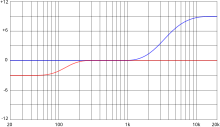Cowtail filter
A shelving (also inaccurate Kuhschwanzregler on English shelving filter ) is an audio filter or tone controls for analog or digital sound processing of the ends of the frequency response .
Its name is derived from the appearance of the frequency response characteristic, which has the shape of a cow's tail. It also resembles the schematic profile of the shelf , from which the English name is derived.
Effect and functionality
The effect of the filter begins slowly at the cut-off frequency and increases dynamically to the end of the frequency range.
Shelving filters are used to change the amplitudes of the high or low range. The desired level is lowered (attenuated) or raised (amplified) from a certain frequency in a cowtail or whip shape. In the case of amplification, the frequency response is visually similar to the profile of a continental shelf: the level is steadily increased and finally remains at the increased level.
This "base", which is formed by a second time constant , distinguishes the action of a shelving filter from that of a high or low pass . In contrast to these, a shelving filter is used to lower and raise the frequency.
The characteristic of a shelving filter also differs from that of a bell-shaped frequency change with the help of equalizers .
The functionality of the adjacent circuit can be explained in simplified form as follows: In the left branch of the circuit for setting the bass component , the potentiometer is practically short-circuited by the capacitor connected in parallel for high frequencies and is therefore ineffective for these. In contrast, in the right-hand part of the circuit, which is arranged in parallel, low frequencies are blocked by two capacitors, so that the potentiometer only acts as an adjuster for high frequency components. The output signals of these two individual filters are combined into a single output signal via coupling resistors.
Web links
- Definition of “shelving filter” on www.itwissen.info
- Test report of a loudspeaker in the online magazine amazona.de with graphic representations of the frequency response characteristics of a cow-tail filter
literature
Hubert Henle: The recording studio manual . 3. Edition. GC Carstensen, Munich 1993, ISBN 3-9802026-5-8 .
Individual evidence
- ↑ Henle 1993 p. 167: These equalizers are also called “shelving equalizers” because of their control curve. In English [...] "Shelving" [...].

